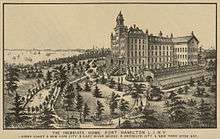Washingtonian movement
The Washingtonian movement (Washingtonians, Washingtonian Temperance Society or Washingtonian Total Abstinence Society) was a 19th-century fellowship founded on April 2, 1840 by six alcoholics (William Mitchell, David Hoss, Charles Anderson, George Steer, Bill M'Curdy, and Tom Campbell) at Chase's Tavern on Liberty Street in Baltimore, Maryland. The idea was that by relying on each other, sharing their alcoholic experiences and creating an atmosphere of conviviality, they could keep each other sober. Total abstinence from alcohol was their goal. The group taught sobriety and preceded Alcoholics Anonymous by almost a century. Members sought out other "drunkards" (the term alcoholic had not yet been created), told them their experiences with alcohol abuse and how the Society had helped them achieve sobriety. With the passage of time the Society became a prohibitionist organization in that it promoted the legal and mandatory prohibition of alcoholic beverages. The Society was the inspiration for Timothy Shay Arthur's Six Nights with the Washingtonians and his Ten Nights in a Bar-Room.
The Washingtonians differed from the temperance movement in that they focused on the individual alcoholic rather than on society's greater relationship with liquor. In the mid-19th century, a temperance movement was in full sway across the United States and temperance workers advanced their anti-alcohol views on every front. Public temperance meetings were frequent and the main thread was prohibition of alcohol and pledges of sobriety to be made by the individual.

Concurrent with this movement, a loose network of facilities both public and private offered treatment to drunkards. Referred to as inebriate asylums and reformatory homes, they included the New York State Inebriate Asylum, The Inebriate Home of Long Island, N.Y., the Home for Incurables in San Francisco, the Franklin Reformatory Home in Philadelphia and the Washingtonian Homes which opened in Boston and Chicago in 1857.
Washingtonians at their peak numbered in the tens of thousands, possibly as high as 600,000.[1] However, in the space of just a few years, this society all but disappeared because they became fragmented in their primary purpose, becoming involved with all manner of controversial social reforms including prohibition, sectarian religion, politics and abolition of slavery. It is believed that Abraham Lincoln attended and spoke at one of the great revivals, presumably not for treatment, but out of interest in various issues being discussed.[1]
The Washingtonians drifted away from their initial purpose of helping the individual alcoholic, and disagreements, infighting, and controversies over prohibition eventually destroyed the group. The Washingtonians became so thoroughly extinct that, some 50 years later in 1935 when William Griffith Wilson and Dr. Robert Smith joined together in forming Alcoholics Anonymous, neither of them had ever heard of the Washingtonians. Although comparisons are made between the Washingtonians and Alcoholics Anonymous, in some respects they have more in common with modern secular addiction recovery groups. The Washingtonians were so non-religious and non-spiritual that religious critics accused them of humanism and placing themselves before the power of God.[2]
See also
References
- 1 2 White, Charles (1921). Lincoln and Prohibition. Abingdon. pp. 40–45.
- ↑ White, William L. (2001). "Pre-A.A. Alcoholic Mutual Aid Societies". Alcoholism Treatment Quarterly. 19 (2): 1–21. doi:10.1300/J020v19n02_01. ISSN 1544-4538.
While there are similarities between A.A. and the Washingtonians, the Washingtonians were so distinctly non-religious and non-spiritual in orientation that they were charged by their religious critics with the heresy of humanism (placing their own power above the power of God)
- Blumberg, Leonard U. The significance of the alcohol prohibitionists for the Washingtonian Temperance Society. The Journal of Studies on Alcohol, 1980, 41(L).
- Koch, Donald A. A Dictionary of Literary Biographers; Antebellum Writers in New York and the South. Vol 3. Myers, Joe (Ed.) : Detroit: Bruccoli, 1979, 3-7.
- Leonard U. Blumberg & William L. Pittman, Beware the First Drink! The Washingtonian Temperance Movement and Alcoholics Anonymous, Seattle: Glen Abbey Books, 1991, ISBN 0-934125-22-8.
- Blocker, Jack S. et al. (Eds.), Alcohol and Temperance in Modern History, vol. 2, Santa Barbara: ABC-Clio 2003.
External links
- Abraham Lincoln's Temperance address to the Washingtonians, 1842
- Washingtonian Forebears of Alcoholics Anonymous